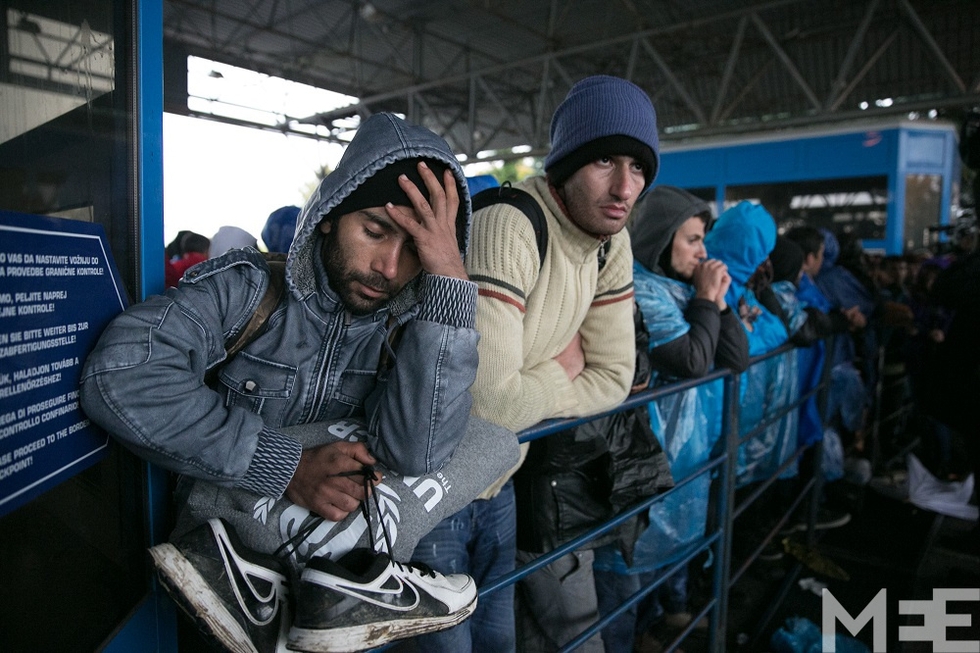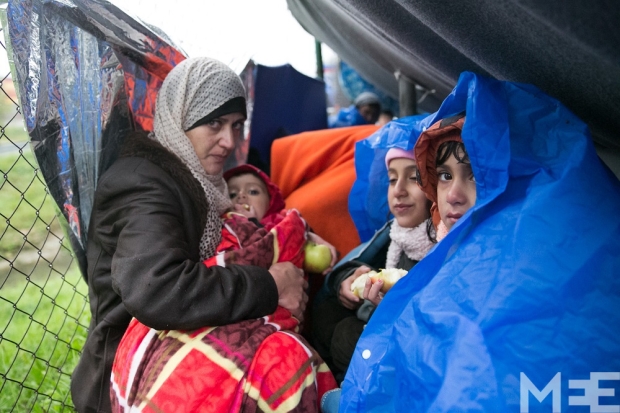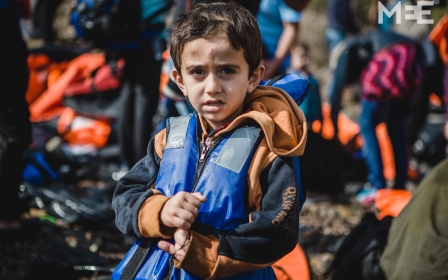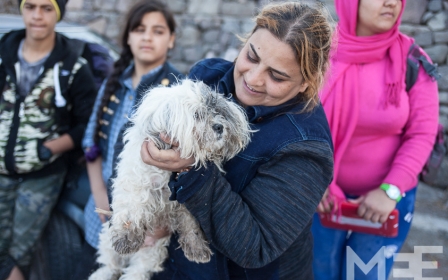Trapped refugees face freezing hell in the Balkans as winter sets in

CAKOVEC, Croatia - Refugees from war-torn Middle Eastern countries are increasingly being left stranded on the borders of Balkan countries as European borders close and the rain and cold of winter set in.
For months, these borders have been closing and re-opening periodically but the situation has deteriorated sharply in recent days. While Croatia - which has taken in 210,000 refugees since mid-September – re-opened its border with Serbia on Monday, it has been enforcing restrictions on entry, only letting in groups of around 50 to 100 people in at a time.
Since the restrictions were tightened on Tuesday evening, 3,500 refugees and migrants have been once again stranded at the Berkasovo-Bapska crossing. After enduring wet and near freezing conditions overnight, many people decided to brave alternative routes, journeying around the main border station to enter Croatia illegally through fields and orchards on Wednesday morning.
Many refugees - coming from countries like Syria, Iraq but also Afghanistan and Iran - reported being seperated from their families at the border.
“I waited on the border with Croatia for three days without food in the rain, in the water, in the mud , Bachar Khan, a 24-year-old journalist from Nuristan, Afghanistan, who was waiting to be taken off of a train at Cakovec in northern Croatia said. “I lost my whole family.”
“I looked and there is my wife, on the other side, and I was here - I wanted to go with my wife but I couldn’t get through. My wife is pregnant. I don’t know where she is now. I don’t know anything… I lost everything.”
Once in Croatia, people tend to make their way north, but with closures also being enacted in neighbouring Hungary and Slovenia, bottlenecks are building up across the Balkans.
Hungary closed its border with Croatia last Friday at midnight, halting the flow of refugees along a well-trodden route through the country to Austria.
Hungary has since been prosecuting and imprisoning anyone who tries to get through the steel and razor-wire fence it completed on its southern border.
In response to this border closure, Slovenia agreed to allow refugees through its territory towards Austria, but has attempted to limit the flow of people entering each day, leaving, at times, thousands of refugees waiting on its border.
Some 20,000 refugees have entered Slovenia since Saturday morning, despite the country initially saying it would only accept 2,500 people a day.
On Monday, however, Slovenia shut its border at Sredisce ob Dravi, leaving up to 1,500 refugees stuck in the rain and cold for 20 hours, with Croatian police blocking them from re-entering Croatia.
At around 1am local time, Croatian police disembarked the people from a train in the border town and told them to talk towards Slovenia, but Slovenian police barricaded their side of the border with metal barriers and threatened anyone trying to get past with truncheons and tazers.
Men, women, children and babies were forced to spend almost 24 hours waiting outside in torrential rain in a 100m stretch between the two countries’ border posts in temperatures just a little over freezing.
“Why are they keeping us here like this? Look at these children,” said Mustafa, a 30-year-old, former hotel worker from Syria, said pointing at three children huddling for warmth with their mother next to him. “These children will die if they don’t let us go.”
People built fires out of anything they could find and huddled in half a dozen small tents, a tipped over rubbish skip and under blankets slung over a fence. At least three people were hospitalised for exposure to the cold.
“Three people were hospitalised including a pregnant lady and a young lady with kidney problems - but we must say that the reaction of the local ambulance and the medical team on the spot was amazingly fast,” Mario Pavlovic, UNHCR Associate protection officer for Croatia, who was on the ground on Monday said.
“I’ve working as a humanitarian with UNHCR for 23 years since 1992 [when the war between Serbia and Croatia was happening] and it was particularly difficult to spend these hours with the people on the ground on Monday,” Pavlovic said.
Nor was the situation much better for some of those who were able to cross.
Amina, a 33-year-old pharmacist, and her husband, Nahal, a 39-year-old mechanic from Idlib, walked for days with their two sons aged eight and nine before reaching a camp in Slovenia from where they hoped to get to Austria and eventually Sweden.
"It was cold, very very cold. Thousands were walking," Amina said. "The journey in Europe has been difficult, especially for my children; we are all so tired; we wish we'd remained in Syria; the journey has made me very sad."
Amina told MEE that the conditions in the Slovenian camp in Sredisce ob Dravi were very cramped and that 300 people were sleeping in six tents, with only 150 beds between them.
"Can we change tents? There are no families in our tent, only men," she said.
On Wednesday, migrants and refugees apparently lit fire to their transit camp in Brezice some 5 kilometers from the Croatia border after reportedly complaining about the lack of food, water and blankets and the slow process of moving them to the Austrian border.
"In view of the unfolding emergency in the countries along the Western Balkans migratory route,” the European Commission said in a statement on Wednesday. “There is a need for much greater cooperation, more extensive consultation and immediate operational action.”
Rather than taking a more integrated approach with neighboring countries, however, several Balkan states are now openly falling out over how to deal with the influx of refugees.
On Tuesday, angered at Croatia not respecting its 2,500-refugees-a-day quota, Slovenia’s interior state secretary, Bostjan Sefic, said building a border fence with Croatia was a possibility.
"Safeguarding border crossings with physical obstacles" could not be ruled out, he said.
Zoran Milanovic, the Croatian Prime Minister, said in response that he would not let refugees “pile up” in Croatia.
“When I see the Slovenians start building a wall like the Hungarians, we will build it twice as fast ... Any fool can build a wall. It’s not the solution,” he said.
Slovenia’s parliament on Wednesday voted to deploy its army to help Slovenian police guard its border with Croatia
“Where I live in Afghanistan, I am not safe,” said Khan from Afganistan who had lost his wife at the Croatia-Serbia border.
“[But] it’s so difficult. If I’d known Europe would be like this - I wouldn’t have come to Europe… Is all Europe like this? I don’t want it if it is.”
Police brutality
After having crossed the Serbian-Croatian border, refugees are, in some cases, having to walk in the rain and freezing temperatures for several hours in order to reach the overflowing camps inside Croatia. Some have reported being beaten by Croatian police on the border.
“The Croatian police beat us very bad’, said Shanawar Nawaz, a 29-year-old car salesman from Kunduz, Afghanistan, who claimed he had been waited on the border for ten hours in the rain.
“Some people started to push, and the police pushed back and hit people. They abused us with sticks and they tazered people.”
“Don’t tell the Croatian police I said this. They will beat me again,” he added while looking nervously round the shoulder.
Several other men MEE spoke to near the border gave similar stories.
According to Shanawar, once the groups of refugees and migrants they pushed past Croatian police and ran across the border. They walked for 16km “from the Croatian border to a camp,” he said.” We left the border at four o’clock and reached the camp at, I think, 9.45pm in the evening. It was raining. The wind was going very fast. Children were cold, shivering.”
Croatia insists it is now taking steps to update its refugee accommodation for the winter months.
“What we are seeing in Croatia is massive preparations to organise for the winter locations; refugees will be taken care of in a much better condition,” UNHCR’s Pavlovic said
“In Slavonski Brod [border town near the Bosnia and Herzegovina border] they are building a winter location, a reception facility for 5,000 people and UNHCR is currently preparing to assist the government in various preparations,” he said.
But the need remains huge. While in previous years, the number of new arrivals from the Middle East, Asia and Africa have tended to peter out as the colder months hit, this year has seen no such reprieve and
The numbers of refugees starting trips to northern Europe is not declining.
On Monday, 5,000 people landed on the Greek island of Lesbos alone and its registration centre is full to overflowing. As the week has gone on, even more people have flooded in. On Friday, the International Organisation for Migration said that Greece had seen a record influx this week with 48,000 new arrivals coming.
An EU summit on the issue has been called for Sunday, but aid workers fear it might be a case of too little too late and that not enough will be done to create a more efficient and safer “refugee corridor”.
“Winter is coming it’s going to be more challenging,” Barbar Baloch, the UNHCR spokesperson for central Europe said. ”It’s a great concern.”
”A collective response is missing. Europe has not been able to manage the whole issue. Closing borders, putting up fences is not going to be solution to the refugee crisis,“ he added.
New MEE newsletter: Jerusalem Dispatch
Sign up to get the latest insights and analysis on Israel-Palestine, alongside Turkey Unpacked and other MEE newsletters
Middle East Eye delivers independent and unrivalled coverage and analysis of the Middle East, North Africa and beyond. To learn more about republishing this content and the associated fees, please fill out this form. More about MEE can be found here.





